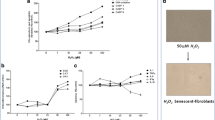Abstract
Background
Reactive oxygen species production is the final step in skin aging. These unstable molecules can damage and destroy DNA, proteins, and membrane phospholipids. The aim of this study was to test the in vitro effect of an antioxidant precursor, N-acetylcysteine (NAC), on human dermal fibroblasts. NAC alone and a solution of NAC and amino acids together, used in aesthetic medicine as intradermal injection treatment, were tested.
Methods
The expression levels of some connective related genes (HAS1, HYAL1, ELN, ELANE, DSP, GDF6, and IGF1) were analyzed on cultures of dermal fibroblasts using real-time reverse-transcription polymerase chain reaction (real time RT-PCR).
Results
All genes were upregulated after 24 h of treatment.
Conclusions
An interesting effect of gene induction by administration of NAC and amino acids in vitro was demonstrated. Upregulation of elastin-, hyaluronic acid-, and GDF6-encoding genes supports the evidence of clinical improvement induced by NAC biostimulation in the prevention and correction of skin aging.
No Level Assigned
This journal requires that authors assign a level of evidence to each submission to which Evidence-Based Medicine rankings are applicable. This excludes Review Articles, Book Reviews, and manuscripts that concern Basic Science, Animal Studies, Cadaver Studies, and Experimental Studies. For a full description of these Evidence-Based Medicine ratings, please refer to the Table of Contents or the online Instructions to Authors http://www.springer.com/00266.



Similar content being viewed by others
References
Avantaggiato A, Palmieri A, Carinci F, Pasin M, Bertuzzi G (2013) Biostimulation and biorevitalization: effects on human skin fibroblasts. Ann Oral Maxillofac Surg 1(2):11
Bertuzzi G (2010) Medicina anti-aging. Academia Universa Press, Milan, pp 188–190
Black HS (1987) Potential involvement of free radical reactions in ultraviolet light-mediated cutaneous damage. Photochem Photobiol 46:213–221
Sohal RS, Weindruch R (1996) Oxidative stress, caloric restriction, and aging. Science 273:59–63
Kohen R, Gati I (2000) Skin low molecular weight antioxidants and their role in aging and in oxidative stress. Toxicology 148:149–157
Cadet J, Douki T (2011) Oxidatively generated damage to DNA by UVA radiation in cells and human skin. J Invest Dermatol 131:1005–1007
Gredilla R (2010) DNA damage and base excision repair in mitochondria and their role in aging. J Aging Res 2011:257093
D’Agostini F, Balansky RM, Camoirano A, De Flora S (2005) Modulation of light-induced skin tumors by N-acetylcysteine and/or ascorbic acid in hairless mice. Carcinogenesis 26:657–664
Kang S, Chung JH, Lee JH, Fisher GJ, Wan YS, Duell EA, Voorhees JJ (2003) Topical N-acetyl cysteine and genistein prevent ultraviolet-light-induced signaling that leads to photoaging in human skin in vivo. J Invest Dermatol 120:835–841
Alaluf S, Muir-Howie H, Hu HL, Evans A, Green MR (2000) Atmospheric oxygen accelerates the induction of a post-mitotic phenotype in human dermal fibroblasts: the key protective role of glutathione. Differentiation 66:147–155
De Flora S, Izzotti A, D’Agostini F, Balansky RM (2001) Mechanisms of N-acetylcysteine in the prevention of DNA damage and cancer, with special reference to smoking-related end-points. Carcinogenesis 22:999–1013
Sun L, Gu L, Wang S, Yuan J, Yang H, Zhu J, Zhang H (2012) N-acetylcysteine protects against apoptosis through modulation of group I metabotropic glutamate receptor activity. PLoS ONE 7(3):e32503
Livak KJ, Schmittgen TD (2001) Analysis of relative gene expression data using real-time quantitative PCR and the 2(-Delta Delta C(T)) method. Methods 25:402–408
Aruoma OI, Halliwell B, Hoey BM, Butler J (1989) The antioxidant action of N-acetylcysteine: its reaction with hydrogen peroxide, hydroxyl radical, superoxide, and hypochlorous acid. Free Radic Biol Med 6:593–597
Issels RD, Nagele A, Eckert KG, Wilmanns W (1988) Promotion of cystine uptake and its utilization for glutathione biosynthesis induced by cysteamine and N-acetylcysteine. Biochem Pharmacol 37:881–888
Morrison JP, Coleman MC, Aunan ES, Walsh SA, Spitz DR, Kregel KC (2005) Thiol supplementation in aged animals alters antioxidant enzyme activity after heat stress. J Appl Physiol 99:2271–2277
De La Fuente M, Victor VM (2000) Anti-oxidant as modulators of immune function. Immunol Cell Biol 7:999–1013
Monslow J, Williams JD, Norton N, Guy CA, Price IK, Coleman SL, Williams NM, Buckland PR, Spicer AP, Topley N, Davies M, Bowen T (2003) The human hyaluronan synthase genes: genomic structures, proximal promoters and polymorphic microsatellite markers. Int J Biochem Cell Biol 35:1272–1283
Laurent TC, Fraser JR (1992) Hyaluronan. FASEB J 6:2397–2404
Rosenbloom J (1984) Elastin: relation of protein and gene structure to disease. Lab Invest 51:605–623
Uitto J, Christiano AM, Kahari VM, Bashir MM, Rosenbloom J (1991) Molecular biology and pathology of human elastin. Biochem Soc Trans 19:824–829
Chua F, Laurent GJ (2006) Neutrophil elastase: mediator of extracellular matrix destruction and accumulation. Proc Am Thorac Soc 3:424–427
Vanderburg CR, Hay ED (1996) E-cadherin transforms embryonic corneal fibroblasts to stratified epithelium with desmosomes. Acta Anat (Basel) 157:87–104
Bowers SL, McFadden WA, Borg TK, Baudino TA (2012) Desmoplakin is important for proper cardiac cell–cell interactions. Microsc Microanal 18:107–114
Sawa Y, Kuroshima S, Yamaoka Y, Yoshida S (2005) Intracellular distribution of desmoplakin in human odontoblasts. J Histochem Cytochem 53:1099–1108
Quan T, He T, Kang S, Voorhees JJ, Fisher GJ (2004) Solar ultraviolet irradiation reduces collagen in photoaged human skin by blocking transforming growth factor-beta type II receptor/Smad signaling. Am J Pathol 165:741–751
Chang C, Hemmati-Brivanlou A (1999) Xenopus GDF6, a new antagonist of noggin and a partner of BMPs. Development 126:3347–3357
Banka S, Cain SA, Carim S, Daly SB, Urquhart JE, Erdem G, Harris J, Bottomley M, Donnai D, Kerr B, Kingston H, Kingston H, Superti-Furga A, Unger S, Ennis H, Worthington J, Worthington J, Worthington J, Herrick AL, Merry CL, Yue WW, Kielty CM, Newman WG (2014) Leri’s pleonosteosis, a congenital rheumatic disease, results from microduplication at 8q22.1 encompassing GDF6 and SDC2 and provides insight into systemic sclerosis pathogenesis. Ann Rheum Dis. doi:10.1136/annrheumdis-2013-204309
Conflict of interest
The authors have no conflicts of interest to disclose.
Author information
Authors and Affiliations
Corresponding author
Rights and permissions
About this article
Cite this article
Avantaggiato, A., Bertuzzi, G., Vitiello, U. et al. Role of Antioxidants in Dermal Aging: An In Vitro Study by q-RT-PCR. Aesth Plast Surg 38, 1011–1016 (2014). https://doi.org/10.1007/s00266-014-0380-9
Received:
Accepted:
Published:
Issue Date:
DOI: https://doi.org/10.1007/s00266-014-0380-9




